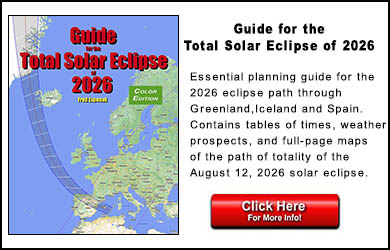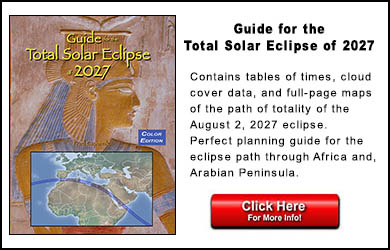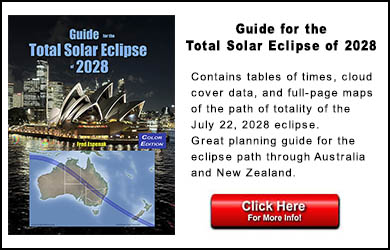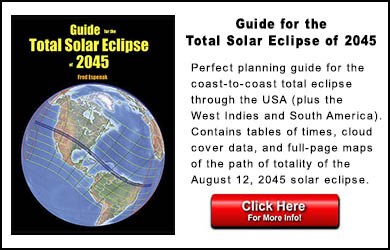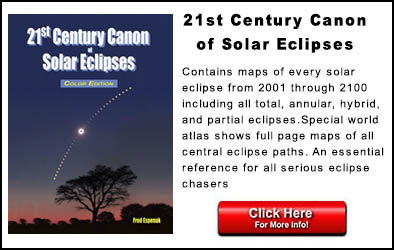Global Map Animations of Solar Eclipses: 2001 - 2100
Fred Espenak and Michael Zeiler
Global Map Animations of Solar Eclipses: 2001 - 2010
Michael Zeiler GreatAmericanEclipse.com and Fred Espenak EclipseWise.com have created a series of eclipse animations - one for every solar eclipse during the 21st Century.
The animations show the path of the Moon's shadows as they sweep across a global map of Earth (an orthographic projection). The vantage point of the animation is as seen from the Moon. The daylight hemisphere of Earth then faces the Moon and the lunar shadows appear perfectly circular with no distorted projection effects as they race across Earth. Another consequence of this viewing geometry is that the Moon's shadows move across the disk of Earth in a straight line.
For all eclipses, the Moon's large, pale penumbral shadow appears as a lightly shaded circle and is outlined with a solid black edge. For Total, Annular, and Hybrid eclipses, the Moon's much smaller inner shadow (either umbra or antumbral) appears as a tiny black disk and tracks along the path of totality or annularity (yellow strip). A partial eclipse is visible from within the penumbra, while a total or annular eclipse is visible inside the umbra or antumbra.
Each animation includes important information in the four corners. In the upper left corner is the type of eclipse and the eclipse date. To the upper right is the Universal Time. The lower left corner displays the instantaneous duration of totality or annularity (not used for partial eclipses). To the lower right is the credit for the animation.
Animations are available in three sizes/resolutions: small (300 x 300 pixels), medium (400 x 400 pixels), and large (800 x 800 pixels). They can be viewed through the links below each thumbnail.

These animations may be freely used through Creative Commons.
You may use and distribute these eclipse animations as long as they are not modified and you include an attribution.
Solar Eclipse Global Animation by
Fred Espenak and Michael Zeiler
is licensed under a Creative Commons Attribution-NoDerivatives 4.0 International License.
Based on work at EclipseWise.com
and GreatAmericanEclipse.com
Attribution: "Global Map Animation of Solar Eclipse courtesy of Michael Zeiler (GreatAmericanEclipse.com) and Fred Espenak (EclipseWise.com)".
Global Map Animations of Solar Eclipses: 2011 - 2020
Michael Zeiler GreatAmericanEclipse.com and Fred Espenak EclipseWise.com have created a series of eclipse animations - one for every solar eclipse during the 21st Century.
The animations show the path of the Moon's shadows as they sweep across a global map of Earth (an orthographic projection). The vantage point of the animation is as seen from the Moon. The daylight hemisphere of Earth then faces the Moon and the lunar shadows appear perfectly circular with no distorted projection effects as they race across Earth. Another consequence of this viewing geometry is that the Moon's shadows move across the disk of Earth in a straight line.
For all eclipses, the Moon's large, pale penumbral shadow appears as a lightly shaded circle and is outlined with a solid black edge. For Total, Annular, and Hybrid eclipses, the Moon's much smaller inner shadow (either umbra or antumbral) appears as a tiny black disk and tracks along the path of totality or annularity (yellow strip). A partial eclipse is visible from within the penumbra, while a total or annular eclipse is visible inside the umbra or antumbra.
Each animation includes important information in the four corners. In the upper left corner is the type of eclipse and the eclipse date. To the upper right is the Universal Time. The lower left corner displays the instantaneous duration of totality or annularity (not used for partial eclipses). To the lower right is the credit for the animation.
Animations are available in three sizes/resolutions: small (300 x 300 pixels), medium (400 x 400 pixels), and large (800 x 800 pixels). They can be viewed through the links below each thumbnail.

These animations may be freely used through Creative Commons.
You may use and distribute these eclipse animations as long as they are not modified and you include an attribution.
Solar Eclipse Global Animation by
Fred Espenak and Michael Zeiler
is licensed under a Creative Commons Attribution-NoDerivatives 4.0 International License.
Based on work at EclipseWise.com
and GreatAmericanEclipse.com
Attribution: "Global Map Animation of Solar Eclipse courtesy of Michael Zeiler (GreatAmericanEclipse.com) and Fred Espenak (EclipseWise.com)".
Global Map Animations of Solar Eclipses: 2021 - 2030
Michael Zeiler GreatAmericanEclipse.com and Fred Espenak EclipseWise.com have created a series of eclipse animations - one for every solar eclipse during the 21st Century.
The animations show the path of the Moon's shadows as they sweep across a global map of Earth (an orthographic projection). The vantage point of the animation is as seen from the Moon. The daylight hemisphere of Earth then faces the Moon and the lunar shadows appear perfectly circular with no distorted projection effects as they race across Earth. Another consequence of this viewing geometry is that the Moon's shadows move across the disk of Earth in a straight line.
For all eclipses, the Moon's large, pale penumbral shadow appears as a lightly shaded circle and is outlined with a solid black edge. For Total, Annular, and Hybrid eclipses, the Moon's much smaller inner shadow (either umbra or antumbral) appears as a tiny black disk and tracks along the path of totality or annularity (yellow strip). A partial eclipse is visible from within the penumbra, while a total or annular eclipse is visible inside the umbra or antumbra.
Each animation includes important information in the four corners. In the upper left corner is the type of eclipse and the eclipse date. To the upper right is the Universal Time. The lower left corner displays the instantaneous duration of totality or annularity (not used for partial eclipses). To the lower right is the credit for the animation.
Animations are available in three sizes/resolutions: small (300 x 300 pixels), medium (400 x 400 pixels), and large (800 x 800 pixels). They can be viewed through the links below each thumbnail.

These animations may be freely used through Creative Commons.
You may use and distribute these eclipse animations as long as they are not modified and you include an attribution.
Solar Eclipse Global Animation by
Fred Espenak and Michael Zeiler
is licensed under a Creative Commons Attribution-NoDerivatives 4.0 International License.
Based on work at EclipseWise.com
and GreatAmericanEclipse.com
Attribution: "Global Map Animation of Solar Eclipse courtesy of Michael Zeiler (GreatAmericanEclipse.com) and Fred Espenak (EclipseWise.com)".
Global Map Animations of Solar Eclipses: 2031 - 2040
Michael Zeiler GreatAmericanEclipse.com and Fred Espenak EclipseWise.com have created a series of eclipse animations - one for every solar eclipse during the 21st Century.
The animations show the path of the Moon's shadows as they sweep across a global map of Earth (an orthographic projection). The vantage point of the animation is as seen from the Moon. The daylight hemisphere of Earth then faces the Moon and the lunar shadows appear perfectly circular with no distorted projection effects as they race across Earth. Another consequence of this viewing geometry is that the Moon's shadows move across the disk of Earth in a straight line.
For all eclipses, the Moon's large, pale penumbral shadow appears as a lightly shaded circle and is outlined with a solid black edge. For Total, Annular, and Hybrid eclipses, the Moon's much smaller inner shadow (either umbra or antumbral) appears as a tiny black disk and tracks along the path of totality or annularity (yellow strip). A partial eclipse is visible from within the penumbra, while a total or annular eclipse is visible inside the umbra or antumbra.
Each animation includes important information in the four corners. In the upper left corner is the type of eclipse and the eclipse date. To the upper right is the Universal Time. The lower left corner displays the instantaneous duration of totality or annularity (not used for partial eclipses). To the lower right is the credit for the animation.
Animations are available in three sizes/resolutions: small (300 x 300 pixels), medium (400 x 400 pixels), and large (800 x 800 pixels). They can be viewed through the links below each thumbnail.

These animations may be freely used through Creative Commons.
You may use and distribute these eclipse animations as long as they are not modified and you include an attribution.
Solar Eclipse Global Animation by
Fred Espenak and Michael Zeiler
is licensed under a Creative Commons Attribution-NoDerivatives 4.0 International License.
Based on work at EclipseWise.com
and GreatAmericanEclipse.com
Attribution: "Global Map Animation of Solar Eclipse courtesy of Michael Zeiler (GreatAmericanEclipse.com) and Fred Espenak (EclipseWise.com)".
Global Map Animations of Solar Eclipses: 2041 - 2050
Michael Zeiler GreatAmericanEclipse.com and Fred Espenak EclipseWise.com have created a series of eclipse animations - one for every solar eclipse during the 21st Century.
The animations show the path of the Moon's shadows as they sweep across a global map of Earth (an orthographic projection). The vantage point of the animation is as seen from the Moon. The daylight hemisphere of Earth then faces the Moon and the lunar shadows appear perfectly circular with no distorted projection effects as they race across Earth. Another consequence of this viewing geometry is that the Moon's shadows move across the disk of Earth in a straight line.
For all eclipses, the Moon's large, pale penumbral shadow appears as a lightly shaded circle and is outlined with a solid black edge. For Total, Annular, and Hybrid eclipses, the Moon's much smaller inner shadow (either umbra or antumbral) appears as a tiny black disk and tracks along the path of totality or annularity (yellow strip). A partial eclipse is visible from within the penumbra, while a total or annular eclipse is visible inside the umbra or antumbra.
Each animation includes important information in the four corners. In the upper left corner is the type of eclipse and the eclipse date. To the upper right is the Universal Time. The lower left corner displays the instantaneous duration of totality or annularity (not used for partial eclipses). To the lower right is the credit for the animation.
Animations are available in three sizes/resolutions: small (300 x 300 pixels), medium (400 x 400 pixels), and large (800 x 800 pixels). They can be viewed through the links below each thumbnail.

These animations may be freely used through Creative Commons.
You may use and distribute these eclipse animations as long as they are not modified and you include an attribution.
Solar Eclipse Global Animation by
Fred Espenak and Michael Zeiler
is licensed under a Creative Commons Attribution-NoDerivatives 4.0 International License.
Based on work at EclipseWise.com
and GreatAmericanEclipse.com
Attribution: "Global Map Animation of Solar Eclipse courtesy of Michael Zeiler (GreatAmericanEclipse.com) and Fred Espenak (EclipseWise.com)".
Global Map Animations of Solar Eclipses: 2051 - 2060
Michael Zeiler GreatAmericanEclipse.com and Fred Espenak EclipseWise.com have created a series of eclipse animations - one for every solar eclipse during the 21st Century.
The animations show the path of the Moon's shadows as they sweep across a global map of Earth (an orthographic projection). The vantage point of the animation is as seen from the Moon. The daylight hemisphere of Earth then faces the Moon and the lunar shadows appear perfectly circular with no distorted projection effects as they race across Earth. Another consequence of this viewing geometry is that the Moon's shadows move across the disk of Earth in a straight line.
For all eclipses, the Moon's large, pale penumbral shadow appears as a lightly shaded circle and is outlined with a solid black edge. For Total, Annular, and Hybrid eclipses, the Moon's much smaller inner shadow (either umbra or antumbral) appears as a tiny black disk and tracks along the path of totality or annularity (yellow strip). A partial eclipse is visible from within the penumbra, while a total or annular eclipse is visible inside the umbra or antumbra.
Each animation includes important information in the four corners. In the upper left corner is the type of eclipse and the eclipse date. To the upper right is the Universal Time. The lower left corner displays the instantaneous duration of totality or annularity (not used for partial eclipses). To the lower right is the credit for the animation.
Animations are available in three sizes/resolutions: small (300 x 300 pixels), medium (400 x 400 pixels), and large (800 x 800 pixels). They can be viewed through the links below each thumbnail.

These animations may be freely used through Creative Commons.
You may use and distribute these eclipse animations as long as they are not modified and you include an attribution.
Solar Eclipse Global Animation by
Fred Espenak and Michael Zeiler
is licensed under a Creative Commons Attribution-NoDerivatives 4.0 International License.
Based on work at EclipseWise.com
and GreatAmericanEclipse.com
Attribution: "Global Map Animation of Solar Eclipse courtesy of Michael Zeiler (GreatAmericanEclipse.com) and Fred Espenak (EclipseWise.com)".
Global Map Animations of Solar Eclipses: 2061 - 2070
Michael Zeiler GreatAmericanEclipse.com and Fred Espenak EclipseWise.com have created a series of eclipse animations - one for every solar eclipse during the 21st Century.
The animations show the path of the Moon's shadows as they sweep across a global map of Earth (an orthographic projection). The vantage point of the animation is as seen from the Moon. The daylight hemisphere of Earth then faces the Moon and the lunar shadows appear perfectly circular with no distorted projection effects as they race across Earth. Another consequence of this viewing geometry is that the Moon's shadows move across the disk of Earth in a straight line.
For all eclipses, the Moon's large, pale penumbral shadow appears as a lightly shaded circle and is outlined with a solid black edge. For Total, Annular, and Hybrid eclipses, the Moon's much smaller inner shadow (either umbra or antumbral) appears as a tiny black disk and tracks along the path of totality or annularity (yellow strip). A partial eclipse is visible from within the penumbra, while a total or annular eclipse is visible inside the umbra or antumbra.
Each animation includes important information in the four corners. In the upper left corner is the type of eclipse and the eclipse date. To the upper right is the Universal Time. The lower left corner displays the instantaneous duration of totality or annularity (not used for partial eclipses). To the lower right is the credit for the animation.
Animations are available in three sizes/resolutions: small (300 x 300 pixels), medium (400 x 400 pixels), and large (800 x 800 pixels). They can be viewed through the links below each thumbnail.

These animations may be freely used through Creative Commons.
You may use and distribute these eclipse animations as long as they are not modified and you include an attribution.
Solar Eclipse Global Animation by
Fred Espenak and Michael Zeiler
is licensed under a Creative Commons Attribution-NoDerivatives 4.0 International License.
Based on work at EclipseWise.com
and GreatAmericanEclipse.com
Attribution: "Global Map Animation of Solar Eclipse courtesy of Michael Zeiler (GreatAmericanEclipse.com) and Fred Espenak (EclipseWise.com)".
Global Map Animations of Solar Eclipses: 2071 - 2080
Michael Zeiler GreatAmericanEclipse.com and Fred Espenak EclipseWise.com have created a series of eclipse animations - one for every solar eclipse during the 21st Century.
The animations show the path of the Moon's shadows as they sweep across a global map of Earth (an orthographic projection). The vantage point of the animation is as seen from the Moon. The daylight hemisphere of Earth then faces the Moon and the lunar shadows appear perfectly circular with no distorted projection effects as they race across Earth. Another consequence of this viewing geometry is that the Moon's shadows move across the disk of Earth in a straight line.
For all eclipses, the Moon's large, pale penumbral shadow appears as a lightly shaded circle and is outlined with a solid black edge. For Total, Annular, and Hybrid eclipses, the Moon's much smaller inner shadow (either umbra or antumbral) appears as a tiny black disk and tracks along the path of totality or annularity (yellow strip). A partial eclipse is visible from within the penumbra, while a total or annular eclipse is visible inside the umbra or antumbra.
Each animation includes important information in the four corners. In the upper left corner is the type of eclipse and the eclipse date. To the upper right is the Universal Time. The lower left corner displays the instantaneous duration of totality or annularity (not used for partial eclipses). To the lower right is the credit for the animation.
Animations are available in three sizes/resolutions: small (300 x 300 pixels), medium (400 x 400 pixels), and large (800 x 800 pixels). They can be viewed through the links below each thumbnail.

These animations may be freely used through Creative Commons.
You may use and distribute these eclipse animations as long as they are not modified and you include an attribution.
Solar Eclipse Global Animation by
Fred Espenak and Michael Zeiler
is licensed under a Creative Commons Attribution-NoDerivatives 4.0 International License.
Based on work at EclipseWise.com
and GreatAmericanEclipse.com
Attribution: "Global Map Animation of Solar Eclipse courtesy of Michael Zeiler (GreatAmericanEclipse.com) and Fred Espenak (EclipseWise.com)".
Global Map Animations of Solar Eclipses: 2081 - 2090
Michael Zeiler GreatAmericanEclipse.com and Fred Espenak EclipseWise.com have created a series of eclipse animations - one for every solar eclipse during the 21st Century.
The animations show the path of the Moon's shadows as they sweep across a global map of Earth (an orthographic projection). The vantage point of the animation is as seen from the Moon. The daylight hemisphere of Earth then faces the Moon and the lunar shadows appear perfectly circular with no distorted projection effects as they race across Earth. Another consequence of this viewing geometry is that the Moon's shadows move across the disk of Earth in a straight line.
For all eclipses, the Moon's large, pale penumbral shadow appears as a lightly shaded circle and is outlined with a solid black edge. For Total, Annular, and Hybrid eclipses, the Moon's much smaller inner shadow (either umbra or antumbral) appears as a tiny black disk and tracks along the path of totality or annularity (yellow strip). A partial eclipse is visible from within the penumbra, while a total or annular eclipse is visible inside the umbra or antumbra.
Each animation includes important information in the four corners. In the upper left corner is the type of eclipse and the eclipse date. To the upper right is the Universal Time. The lower left corner displays the instantaneous duration of totality or annularity (not used for partial eclipses). To the lower right is the credit for the animation.
Animations are available in three sizes/resolutions: small (300 x 300 pixels), medium (400 x 400 pixels), and large (800 x 800 pixels). They can be viewed through the links below each thumbnail.

These animations may be freely used through Creative Commons.
You may use and distribute these eclipse animations as long as they are not modified and you include an attribution.
Solar Eclipse Global Animation by
Fred Espenak and Michael Zeiler
is licensed under a Creative Commons Attribution-NoDerivatives 4.0 International License.
Based on work at EclipseWise.com
and GreatAmericanEclipse.com
Attribution: "Global Map Animation of Solar Eclipse courtesy of Michael Zeiler (GreatAmericanEclipse.com) and Fred Espenak (EclipseWise.com)".
Global Map Animations of Solar Eclipses: 2091 - 2100
Michael Zeiler GreatAmericanEclipse.com and Fred Espenak EclipseWise.com have created a series of eclipse animations - one for every solar eclipse during the 21st Century.
The animations show the path of the Moon's shadows as they sweep across a global map of Earth (an orthographic projection). The vantage point of the animation is as seen from the Moon. The daylight hemisphere of Earth then faces the Moon and the lunar shadows appear perfectly circular with no distorted projection effects as they race across Earth. Another consequence of this viewing geometry is that the Moon's shadows move across the disk of Earth in a straight line.
For all eclipses, the Moon's large, pale penumbral shadow appears as a lightly shaded circle and is outlined with a solid black edge. For Total, Annular, and Hybrid eclipses, the Moon's much smaller inner shadow (either umbra or antumbral) appears as a tiny black disk and tracks along the path of totality or annularity (yellow strip). A partial eclipse is visible from within the penumbra, while a total or annular eclipse is visible inside the umbra or antumbra.
Each animation includes important information in the four corners. In the upper left corner is the type of eclipse and the eclipse date. To the upper right is the Universal Time. The lower left corner displays the instantaneous duration of totality or annularity (not used for partial eclipses). To the lower right is the credit for the animation.
Animations are available in three sizes/resolutions: small (300 x 300 pixels), medium (400 x 400 pixels), and large (800 x 800 pixels). They can be viewed through the links below each thumbnail.

These animations may be freely used through Creative Commons.
You may use and distribute these eclipse animations as long as they are not modified and you include an attribution.
Solar Eclipse Global Animation by
Fred Espenak and Michael Zeiler
is licensed under a Creative Commons Attribution-NoDerivatives 4.0 International License.
Based on work at EclipseWise.com
and GreatAmericanEclipse.com
Attribution: "Global Map Animation of Solar Eclipse courtesy of Michael Zeiler (GreatAmericanEclipse.com) and Fred Espenak (EclipseWise.com)".
Links to Solar Eclipse Predictions
Decade Tables of Solar Eclipses
Each link in the following table displays a page containing 10 years of solar eclipses. Every eclipse has links to a global map, an interactive Google map, and a dedicated web page for that eclipse.
| Decade Tables of Solar Eclipses | |||||
| Decades | |||||
|---|---|---|---|---|---|
| 1901-1910 | 1911-1920 | 1921-1930 | 1931-1940 | 1941-1950 | |
| 1951-1960 | 1961-1970 | 1971-1980 | 1981-1990 | 1991-2000 | |
| 2001-2010 | 2011-2020 | 2021-2030 | 2031-2040 | 2041-2050 | |
| 2051-2060 | 2061-2070 | 2071-2080 | 2081-2090 | 2091-2100 | |
Century Catologs of Solar Eclipses
Each link in the following table displays a catalog containing 100 years of eclipses.
| Century Catalogs of Solar Eclipses | |||||
| Centuries | |||||
|---|---|---|---|---|---|
| 1001-1100 | 1101-1200 | 1201-1300 | 1301-1400 | 1401-1500 | |
| 1501-1600 | 1601-1700 | 1701-1800 | 1801-1900 | 1901-2000 | |
| 2001-2100 | 2101-2200 | 2201-2300 | 2301-2400 | 2401-2500 | |
| 2501-2600 | 2601-2700 | 2701-2800 | 2801-2900 | 2901-3000 | |
For other centuries, see Six Millennium Catalog of Solar Eclipses: -2999 to +3000
Maps of Solar Eclipse Paths
The World Atlas of Solar Eclipse Paths features maps showing the paths of all total, annular and hybrid eclipses. Each map in the atlas covers a 20-year period. The atlas spans five millennia from -1999 to +3000 (2000 BCE to 3000 CE).
| World Atlas of Solar Eclipse Paths | |||||
| 19th Century | 1801-1820 | 1821-1840 | 1841-1860 | 1861-1880 | 1881-1900 |
|---|---|---|---|---|---|
| 20th Century | 1901-1920 | 1921-1940 | 1941-1960 | 1961-1980 | 1981-2000 |
| 21st Century | 2001-2020 | 2021-2040 | 2041-2060 | 2061-2080 | 2081-2100 |
| 22nd Century | 2101-2120 | 2121-2140 | 2141-2160 | 2161-2180 | 2181-2200 |
For eclipse maps covering other centuries/decades, see World Atlas of Solar Eclipse Paths.
Links to Additional Solar Eclipse Predictions
- Home - home page of EclipseWise with predictions for both solar and lunar eclipses
- Solar Eclipses - primary page for solar eclipse predictions
- Solar Eclipse Links - detailed directory of links
- Solar Eclipse Basics - a primer on solar eclipses
- Solar Eclipses and the Saros - details on the Saros cycle
- Global Map Animations of Solar Eclipses: 2001 - 2100 - animations of every solar eclipse during the 21st Century
- 21st Century World Atlas of Central Solar Eclipses - covers the years 2001 to 2100
- 21st Century Catalog of Solar Eclipses - covers the years 2001 to 2100
- World Atlas of Solar Eclipse Maps - covers the years -2999 to +3000 (3000 BCE to 3000 CE)
- Central Solar Eclipses in the USA - maps for all central solar eclipses in the USA from 1001 to 3000
- Six Millennium Catalog of Solar Eclipses - including the years -2999 to +3000 (3000 BCE to 3000 CE)
- Catalog of Solar Eclipse Saros Series - including Saros series -30 through 190
- Solar Eclipse Search Engine - search for solar eclipses from -1999 to +3000
- Javascript Solar Eclipse Explorer - calculate all solar eclipses visible from a city
- MrEclipse.com - eclipse resources and tips on photography
- Solar Eclipses for Beginners - a primer on solar eclipse basics
- How to Photograph a Solar Eclipse - instructions for imaging an eclipse of the Sun
- MrEclipse Photo Index - an index of solar eclipse photographs

Solar Eclipse Publications
- Eclipse Almanac: 2021 to 2030 - overview of all solar and lunar eclipses for the decade
- 21st Century Canon of Solar Eclipses - covers every solar eclipse from 2001 through 2100
- Thousand Year Canon of Solar Eclipses 1501 to 2500 - basic details about every solar eclipse for 1000 years
- Five Millennium Canon of Solar Eclipses: -1999 to +3000 - the ultimate reference with maps and diagrams
- Five Millennium Catalog of Solar Eclipses: -1999 to +3000 - the ultimate reference containing comprehensive tables
- Atlas of Central Solar Eclipses in the USA - 2,000 years of solar eclipses through North America
- Road Atlas of the Annular Solar Eclipse of 2023 October 14 - detailed maps of the annular eclipse path
- Road Atlas of the Total Solar Eclipse of 2024 April 08 - detailed maps of the total eclipse path
- Astropixels Publishing - link to more eclipse publications
Eclipse Predictions
The eclipse predictions presented here were generated using the JPL DE406 solar and lunar ephemerides. The lunar coordinates have been calculated with respect to the Moon's Center of Mass.
Acknowledgments
Some of the content on this web site is based on the book Thousand Year Canon of Solar Eclipses 1501 to 2500. All eclipse calculations are by Fred Espenak, and he assumes full responsibility for their accuracy.
Permission is granted to reproduce eclipse data when accompanied by a link to this page and an acknowledgment:
"Eclipse Predictions by Fred Espenak, www.EclipseWise.com"
The use of diagrams and maps is permitted provided that they are NOT altered (except for re-sizing) and the embedded credit line is NOT removed or covered.

































































































































































































































